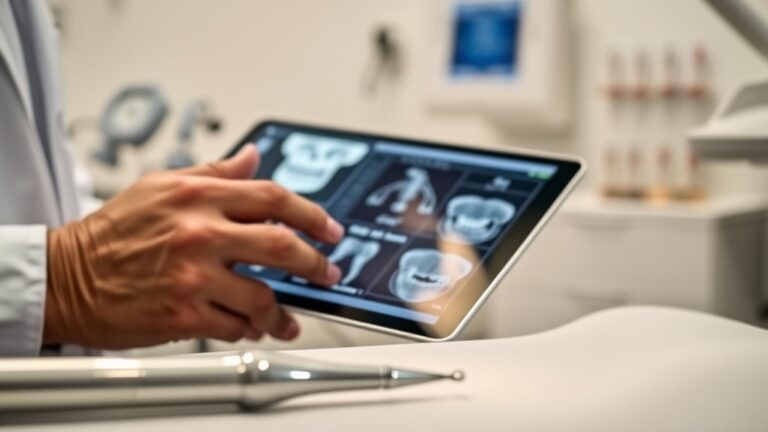Overcoming Barriers in Dental Clinical Data Management Systems
Managing dental clinical data can be a real challenge, especially when it comes to integrating various systems and ensuring that everyone on your team is on board. It's vital to tackle these barriers head-on, but how do you ascertain that your practice adopts effective strategies for interoperability and compliance? As you consider the implications of data integrity and patient care, you'll find that the solutions may not be as straightforward as they seem. What steps can you take to foster a culture of acceptance and efficiency amidst these complexities? If you need assistance navigating these challenges, feel free to contact us. We can connect you with experts who can provide tailored solutions for your practice.
Importance of Data Integration
The importance of data integration in dental clinical data management systems can't be overstated. You'll find that seamless data sharing enhances data accessibility, allowing dental and medical providers to access a patient's entire health history. This access includes essential information like allergies and chronic conditions, which can greatly improve diagnostic accuracy and treatment outcomes. In fact, 68.5% of providers believe that timely access to thorough health information could have positively impacted patient outcomes. Moreover, effective data integration fosters continuity of care by securely transferring patient data between different dental practices. This guarantees that treatments continue without disruption, reducing the need for patients to repeat tests or provide redundant information. When you have all relevant data at your fingertips, you can make more informed treatment decisions while respecting patient privacy. Additionally, the integration of medical and dental data enhances overall health through improved collaboration between providers.
Challenges of Interoperability
While seamless data sharing is essential for enhancing patient care, numerous challenges hinder interoperability in dental clinical data management systems. One major hurdle is the lack of standardized data formats. Different dental technologies often use proprietary formats, leading to inefficiencies in data sharing and storage. Digital imaging systems frequently don't comply with existing dental practice management software, obstructing smooth data exchange. Implementing standardized formats like DICOM can greatly improve this situation. Furthermore, interoperability drives efficiencies that can significantly enhance practice management and patient outcomes.
Integration challenges further complicate matters. Newer dental technologies struggle to fit into established workflows, leaving practice management software and electronic dental records largely siloed from other health records. Inconsistent coding standards, such as SNOWMED and ICD codes, add to the confusion, making data interpretation difficult.
Economic barriers also play a role; the costs and resources needed for achieving interoperability can be overwhelming. Traditional fee-for-service models don't incentivize hospitals or vendors to prioritize interoperability, leaving it overlooked in favor of other pressing capabilities.
Finally, technical and regulatory complexities, including privacy policies and trust issues between health systems, create considerable barriers to effective data sharing. Addressing these challenges is vital for fostering a more interconnected dental care environment.
Ensuring Security and Compliance
Achieving interoperability in dental clinical data management systems is only part of the equation; guaranteeing security and compliance is equally important to protect patient information and maintain trust.
To safeguard sensitive data, implementing robust security measures like data encryption is essential. By encrypting patient data, you make it unreadable without the proper key, which secures data both in transit and at rest. Notably, data breaches in dental practices rose by 45% over the last two years, underscoring the urgency for effective protective measures.
Access controls are another vital component. By establishing granular user access, you guarantee that only authorized personnel can view or modify patient records. Implementing multi-factor authentication further strengthens security by requiring multiple forms of verification beyond just passwords.
Additionally, regular security audits and vulnerability assessments will help you identify and address potential weak points in your systems. Training your staff on HIPAA regulations and best practices is vital to build a culture of compliance within your practice.
Lastly, utilizing practice management software equipped with compliance management tools will align your data practices with legal standards. Together, these measures guarantee that your dental practice not only protects patient information but also upholds the highest standards of security and compliance in the industry.
Effective Patient Record Management
Effective patient record management is vital for delivering quality dental care and guaranteeing seamless communication among health professionals. You need to prioritize record accuracy by meticulously documenting essential patient information, including medical history, treatment plans, and consent forms. This level of detail not only supports effective treatment but also safeguards patient privacy by confirming sensitive information is accurately recorded and securely stored.
Implementing a consistent and standardized charting method, such as the SOAP format, helps maintain clarity across all records. Using templates and a list of standard abbreviations minimizes errors and confusion, allowing you to focus on patient care rather than paperwork. Additionally, maintaining accurate patient info is essential for effective risk management in your practice.
Timely data entry is key; aim to document interactions while the patient is still in the office, completing notes within 24 hours to uphold accuracy. Inclusion of supporting documentation, like radiographs and treatment progress images, enriches the patient record, providing a thorough view of care.
Keeping a correspondence log for all communications guarantees transparency and accountability, vital elements in respecting patient privacy. Ultimately, effective record management not only enhances patient care but also fosters trust and confidence in your practice.
Streamlining Clinical Documentation
Maintaining accurate patient records is just the beginning; streamlining clinical documentation can greatly enhance overall efficiency in your dental practice. By leveraging automated documentation and AI enhancements, you can notably reduce the time and effort spent on documentation tasks.
Medical dictation software, for instance, enables hands-free clinical documentation, allowing dental assistants to focus on patient care instead of paperwork. Additionally, the ability to eliminate paper records significantly cuts costs and reduces the ecological footprint associated with traditional documentation methods.
AI-powered technologies like Sunoh.ai can generate thorough dental records within minutes, eliminating the hours typically dedicated to manual entry. This guarantees not only speed but also accuracy, minimizing errors and discrepancies in patient records.
With structured templates and predefined formats, AI Medical Scribe software assures precision and uniformity, eradicating common mistakes like typos and grammatical errors.
Moreover, integrating these solutions with your existing Electronic Health Record (EHR) systems can streamline workflows and enhance data integrity.
Regular audits and training sessions will guarantee that your team effectively adopts these technologies, maintaining high standards in clinical data management.
Embracing these advancements not only improves operational efficiency but also empowers your practice to deliver exceptional patient care.
Financial Management Solutions
Integrating financial management solutions into your dental practice not only streamlines operations but also enhances patient experiences. By centralizing financial operations within your practice management software, you create a seamless ecosystem that boosts productivity and fosters financial transparency.
Automated insurance verification processes guarantee accurate benefit checks, minimizing manual tasks and expediting updates to patient charts. The integration of centralized financial services allows for comprehensive data analytics, providing insights that can further improve operational efficiency.
Simplified collections through automated payments and balance notifications allow you to reduce administrative burdens while speeding up cash flow. Offering flexible payment options, including third-party financing plans, helps you address patient affordability concerns effectively. This not only makes dental care more accessible but also strengthens patient trust.
Moreover, data analytics provide insights into patient spending and operational costs, enabling you to optimize pricing strategies that align with your practice's financial goals.
With electronic billing and customized billing options, managing patient accounts becomes more efficient, reducing reimbursement times considerably.
Leveraging Technological Advancements
In today's rapidly evolving dental landscape, leveraging technological advancements is essential for enhancing practice efficiency and patient care. By adopting cloud collaboration, you can gain flexible access to patient records and treatment plans from any location, improving communication among dental professionals. This seamless sharing of information not only boosts productivity but also facilitates efficient practice management, allowing you to schedule appointments and communicate with staff remotely.
Integrating artificial intelligence and predictive analytics into your practice can greatly enhance diagnostic accuracy. AI algorithms analyze vast volumes of clinical data to identify patterns and predict treatment outcomes, enabling you to detect issues like cavities and periodontal disease early. This proactive approach allows for personalized treatment plans that cater to each patient's unique needs. Additionally, the rise of teledentistry allows for convenient consultations from the comfort of patients' homes, further improving access to care.
Moreover, embracing digital imaging tools like CBCT and intraoral cameras can elevate the quality of care you provide. These technologies allow for immediate analysis and high-resolution imaging, improving patient understanding and engagement.
Training for System Adoption
Effective training for system adoption is essential to guaranteeing that dental professionals can fully utilize Clinical Data Management (CDM) systems. To achieve this, structured user training is critical, covering both the system functionality and the best practices in CDM processes.
You'll need to engage users from the outset, emphasizing the rationale behind data collection requirements and instruments. This enhances training effectiveness, guaranteeing that every participant understands their role in maintaining data accuracy.
Implementation strategies should incorporate robust feedback mechanisms, allowing users to voice challenges or suggestions during the training process. By actively involving users, you foster a sense of ownership and commitment to the new system.
Providing ongoing user support post-training is equally significant; it guarantees that any issues arising during system adoption can be promptly addressed. Furthermore, participants can benefit from courses like BI41048 that focus on best practices in Clinical Data Management.
Your training curriculum should encompass key areas, including study design, data collection methods, and quality control.
With hands-on experience using specialized software like Oracle Clinical and Medidata Rave, you'll equip your team with the necessary skills and competencies.
Ultimately, a well-rounded training program paves the way for successful system adoption, enhancing overall data management and improving patient care.
Overcoming Resistance to Change
Recognizing the inherent challenges in adopting new technologies, overcoming resistance to change among staff is essential for the successful implementation of Dental Clinical Data Management Systems.
To foster staff engagement and guarantee a smooth shift, consider the following strategies:
- Involvement in Decision-Making: Include your team in the selection process to build trust and ownership.
- Targeted Training Programs: Implement tailored training to address the specific needs of your staff, reducing the learning curve.
- Change Management Strategies: Develop clear plans to phase in new technologies, minimizing disruptions and guaranteeing integration with existing workflows.
- Emphasizing Positive Outcomes: Highlight the benefits of new systems, such as improved patient care and efficiency, to motivate your team. As the healthcare data volume continues to grow at an unprecedented rate, it is crucial to adapt to these changes for the benefit of both staff and patients.
Encourage open communication throughout this process. Address concerns promptly and provide continuous support.
By fostering a collaborative environment where everyone understands the reasons behind the change, you can create a culture of adaptability that enhances staff engagement and ultimately leads to better patient outcomes.
Future Trends in Data Management
Emerging technologies are poised to revolutionize dental clinical data management, driving improvements in both patient care and operational efficiency. The integration of big data and predictive modeling will enable you to analyze extensive patient datasets, markedly enhancing diagnostic accuracy and treatment strategies.
With artificial intelligence (AI) and machine learning (ML), you can automate data analysis, predict outcomes, and tailor treatment plans based on patient history, guaranteeing personalized care. Predictive analytics will also help identify potential health risks, allowing for proactive interventions that can significantly benefit patient outcomes.
Data visualization tools will play an imperative role in interpreting complex data, allowing you to present insights clearly for better decision-making. For instance, AI-powered computer vision can analyze dental images, identifying issues faster and more accurately than traditional methods.
Meanwhile, cloud-based platforms enhance data interoperability and security, making patient information easily accessible while adhering to HIPAA regulations.
As telehealth and mobile applications become commonplace, patient engagement will improve, fostering continuity in care. By embracing these advancements, you can guarantee your practice remains at the forefront of dental care, ultimately enhancing the patient experience and outcomes.
As you look ahead, leveraging these technologies will be vital for effective data management in your practice.
Frequently Asked Questions
What Are the Costs Associated With Implementing a New Data Management System?
When implementing a new data management system, you'll face significant costs, including software upgrades, hardware purchases, and ongoing maintenance fees. Carefully budgeting for these expenses guarantees a smooth shift and long-term efficiency in your practice.
How Can I Choose the Right Software for My Dental Practice?
When choosing software for your dental practice, prioritize essential software features like patient records and billing. A user-friendly interface enhances efficiency, ensuring your team can focus on providing exceptional care to patients.
What Support Options Are Available for Users of These Systems?
Steering through the digital seas of dental software, you'll find robust user training, dedicated technical support, regular software updates, and vibrant online forums. These resources, along with customer service and troubleshooting aids, empower your practice's success.
How Often Should Data Backups Be Performed in Dental Practices?
You should perform daily backups for effective data loss prevention, ensuring no more than one day of data is lost. Consider incremental backups throughout the day to enhance backup frequency and protect critical information.
What Are Common User Errors in Data Management Systems?
User errors in data management systems often stem from inadequate user training, poor system integration, and outdated software updates. Prioritizing data entry accuracy, error reporting, and user feedback enhances workflow optimization and strengthens data security, ultimately serving patients better.
Conclusion
Navigating the complexities of dental clinical data management can be daunting, but overcoming barriers is achievable through embracing integration and interoperability while fostering a culture of trust. As you enhance training and engage your staff, you'll not only fortify your cybersecurity measures but also streamline workflows and elevate patient care.
If you find yourself facing challenges in these areas, don't hesitate to reach out to us for assistance. Our expert help can save you valuable time, reduce stress, and significantly improve your dental practice. By anticipating future trends together, we can position your practice at the forefront of innovation, transforming challenges into opportunities for growth and efficiency. Let us support you on this journey towards excellence in dental care.





